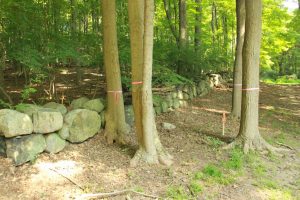Land Development and Trees

As a self-proclaimed treehugger, it is certainly with some trepidation that I reach my arms around trees in order to tag them for removal. But what I have learned from my partner, the Landscape Architect Erin Muir, is that, if undertaken with care and integrity, the removal of some plants can be justified in order to facilitate the improvement of a site’s overall soil health, biodiversity, and capacity for enjoyment.
It is in this spirit that I visited the site of the Pretty Good House in order to tag the trees which will be removed in order for us to build Brave Scout Trail. The private access road will be built on what is very clearly an historical roadbed, which, if we did not have to conform to the straight lines and road specifications of modern life, could probably quite easily meander among the existing trees. But, as it is, we will have to clear some trees to make way for the road – with some more in the future to come down for the driveway, house, and septic system.
In the meantime, and pertinent to this land/tre clearing topic, we are in the process of beginning documentation in order to see if we we be able to meet some, or all, of the requirements of the Living Building Challenge. One of the imperatives for any Living Building Challenge certification (full certification or petal certification) is the “Limits to Growth” imperative. This imperative essentially precludes the building of a “Living Building” on a site which has not been previously developed.
There are nuances to this imperative which can be found in the The Living Future Institute documentation, and we have made a case for our site for the following reasons: we are within walking distance to a major transit hub, we are building on land slated for development which borders protected local, regional and state parkland, and the site was previously cleared. Though The Living Future Institute does not specifically allow looking as far back as 1935, we have an aerial photo from that year, as well as extensive stone walls delineating the site which clearly indicate that it was cleared for development at that time (see red box on the following photograph from 1935).
Many of the trees we are clearing are fairly tall and straight. It is our intention (and I explained this to each tree as I tagged it) to use each tree for it’s best use. We intend to mill the Maple and Oak for cabinets, trim, and flooring. We will use some wood structurally, and some will be returned to the soil, as chips, to begin the Mycorrhizal restoration of the soil.



